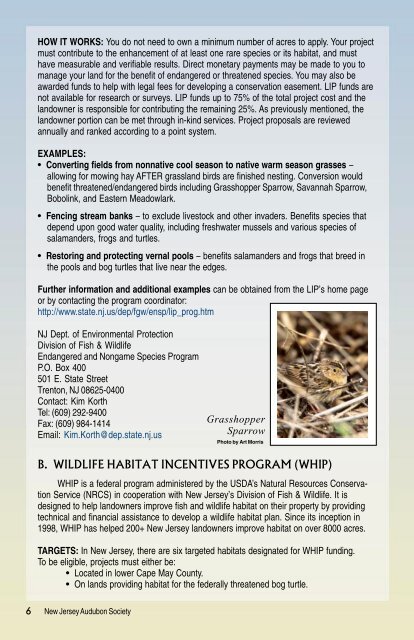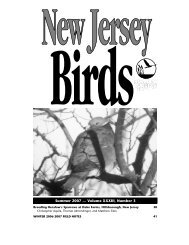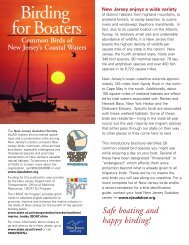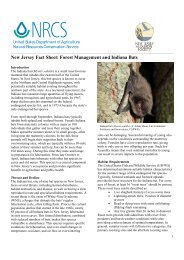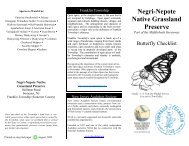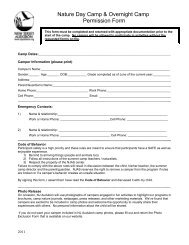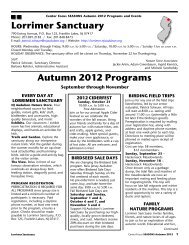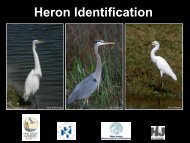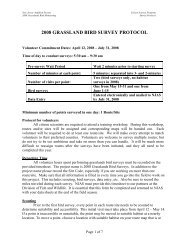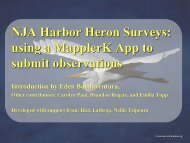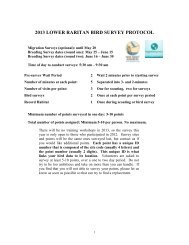Incentive Programs for NJ Landowners - New Jersey Audubon Society
Incentive Programs for NJ Landowners - New Jersey Audubon Society
Incentive Programs for NJ Landowners - New Jersey Audubon Society
You also want an ePaper? Increase the reach of your titles
YUMPU automatically turns print PDFs into web optimized ePapers that Google loves.
HOW IT WORKS: You do not need to own a minimum number of acres to apply. Your project<br />
must contribute to the enhancement of at least one rare species or its habitat, and must<br />
have measurable and verifiable results. Direct monetary payments may be made to you to<br />
manage your land <strong>for</strong> the benefit of endangered or threatened species. You may also be<br />
awarded funds to help with legal fees <strong>for</strong> developing a conservation easement. LIP funds are<br />
not available <strong>for</strong> research or surveys. LIP funds up to 75% of the total project cost and the<br />
landowner is responsible <strong>for</strong> contributing the remaining 25%. As previously mentioned, the<br />
landowner portion can be met through in-kind services. Project proposals are reviewed<br />
annually and ranked according to a point system.<br />
EXAMPLES:<br />
• Converting fields from nonnative cool season to native warm season grasses –<br />
allowing <strong>for</strong> mowing hay AFTER grassland birds are finished nesting. Conversion would<br />
benefit threatened/endangered birds including Grasshopper Sparrow, Savannah Sparrow,<br />
Bobolink, and Eastern Meadowlark.<br />
• Fencing stream banks – to exclude livestock and other invaders. Benefits species that<br />
depend upon good water quality, including freshwater mussels and various species of<br />
salamanders, frogs and turtles.<br />
• Restoring and protecting vernal pools – benefits salamanders and frogs that breed in<br />
the pools and bog turtles that live near the edges.<br />
Further in<strong>for</strong>mation and additional examples can be obtained from the LIP’s home page<br />
or by contacting the program coordinator:<br />
http://www.state.nj.us/dep/fgw/ensp/lip_prog.htm<br />
<strong>NJ</strong> Dept. of Environmental Protection<br />
Division of Fish & Wildlife<br />
Endangered and Nongame Species Program<br />
P.O. Box 400<br />
501 E. State Street<br />
Trenton, <strong>NJ</strong> 08625-0400<br />
Contact: Kim Korth<br />
Tel: (609) 292-9400<br />
Fax: (609) 984-1414<br />
Email: Kim.Korth@dep.state.nj.us<br />
Grasshopper<br />
Sparrow<br />
Photo by Art Morris<br />
B. WILDLIFE HABITAT INCENTIVES PROGRAM (WHIP)<br />
WHIP is a federal program administered by the USDA’s Natural Resources Conservation<br />
Service (NRCS) in cooperation with <strong>New</strong> <strong>Jersey</strong>’s Division of Fish & Wildlife. It is<br />
designed to help landowners improve fish and wildlife habitat on their property by providing<br />
technical and financial assistance to develop a wildlife habitat plan. Since its inception in<br />
1998, WHIP has helped 200+ <strong>New</strong> <strong>Jersey</strong> landowners improve habitat on over 8000 acres.<br />
TARGETS: In <strong>New</strong> <strong>Jersey</strong>, there are six targeted habitats designated <strong>for</strong> WHIP funding.<br />
To be eligible, projects must either be:<br />
• Located in lower Cape May County.<br />
• On lands providing habitat <strong>for</strong> the federally threatened bog turtle.<br />
6 <strong>New</strong> <strong>Jersey</strong> <strong>Audubon</strong> <strong>Society</strong>


